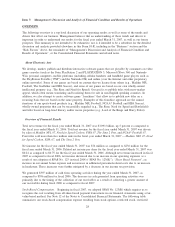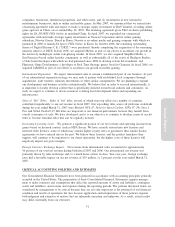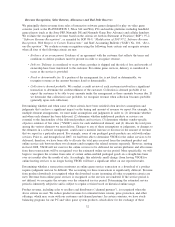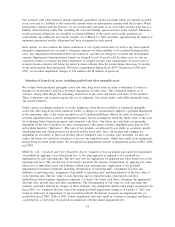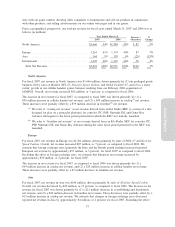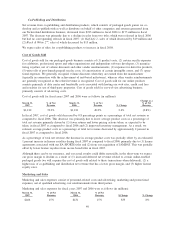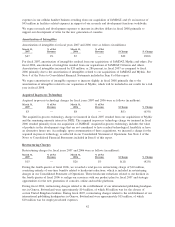Electronic Arts 2007 Annual Report Download - page 108
Download and view the complete annual report
Please find page 108 of the 2007 Electronic Arts annual report below. You can navigate through the pages in the report by either clicking on the pages listed below, or by using the keyword search tool below to find specific information within the annual report.Our contracts with some licensors include minimum guaranteed royalty payments which are initially recorded
as an asset and as a liability at the contractual amount when no performance remains with the licensor. When
performance remains with the licensor, we record guarantee payments as an asset when actually paid and as a
liability when incurred, rather than recording the asset and liability upon execution of the contract. Minimum
royalty payment obligations are classified as current liabilities to the extent such royalty payments are
contractually due within the next twelve months. As of March 31, 2007 and 2006, approximately $9 million of
minimum guaranteed royalty obligations had been recognized in each period.
Each quarter, we also evaluate the future realization of our royalty-based assets as well as any unrecognized
minimum commitments not yet paid to determine amounts we deem unlikely to be realized through product
sales. Any impairments determined before the launch of a product are charged to research and development
expense. Impairments determined post-launch are charged to cost of goods sold. In either case, we rely on
estimated revenue to evaluate the future realization of prepaid royalties and commitments. If actual sales or
revised revenue estimates fall below the initial revenue estimate, then the actual charge taken may be greater
in any given quarter than anticipated. We had no impairments during fiscal 2007. During fiscal 2006 and
2005, we recorded impairment charges of $16 million and $8 million, respectively.
Valuation of Long-Lived Assets, including goodwill and other intangible assets
We evaluate both purchased intangible assets and other long-lived assets in order to determine if events or
changes in circumstances indicate a potential impairment in value exists. This evaluation requires us to
estimate, among other things, the remaining useful lives of the assets and future cash flows of the business.
These evaluations and estimates require the use of judgment. Our actual results could differ materially from
our current estimates.
Under current accounting standards, we make judgments about the recoverability of purchased intangible
assets and other long-lived assets whenever events or changes in circumstances indicate a potential impairment
in the remaining value of the assets recorded on our Consolidated Balance Sheets. In order to determine if a
potential impairment has occurred, management makes various assumptions about the future value of the asset
by evaluating future business prospects and estimated cash flows. Our future net cash flows are primarily
dependent on the sale of products for play on proprietary video game consoles, handheld game players, PCs,
and cellular handsets (“platforms”). The sales of our products are affected by our ability to accurately predict
which platforms and which products we develop will be successful. Also, our revenue and earnings are
dependent on our ability to meet our product release schedules. Due to product sales shortfalls, we may not
realize the future net cash flows necessary to recover our long-lived assets, which may result in an impairment
charge being recorded in the future. We recognized an insignificant amount of impairment in fiscal 2007, 2006
and 2005.
SFAS No. 142, “Goodwill and Other Intangible Assets” requires at least an annual assessment for impairment
of goodwill by applying a fair-value-based test. A two-step approach is required to test goodwill for
impairment for each reporting unit. The first step tests for impairment by applying fair value-based tests at the
reporting unit level. The second step (if necessary) measures the amount of impairment by applying fair value-
based tests to individual assets and liabilities within each reporting unit. Application of the goodwill
impairment test requires judgment, including identification of reporting units, assignment of assets and
liabilities to reporting units, assignment of goodwill to reporting units, and determination of the fair value of
each reporting unit. The fair value of each reporting unit is estimated using a discounted cash flow
methodology which requires significant judgment to estimate the future cash flows, determine the appropriate
discount rates, growth rates and other assumptions. The determination of fair value for each reporting unit
could be materially affected by changes in these estimates and assumptions which could trigger impairment. In
fiscal 2007, we completed the first step of the annual goodwill impairment testing as of January 1, 2007 and
found no indicators of impairment of our recorded goodwill. We did not recognize an impairment loss on
goodwill in fiscal 2007, 2006 or 2005. Future impairment tests may result in a charge to earnings and there is
a potential for a write-down of goodwill in connection with the annual impairment test.
34






